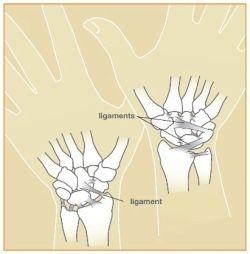Excerpted by Lisa Petrie

Playing-related injuries are more common than you’d think, and differ among instrument groups.
Musicians sometimes have problems with upper extremities (hands and arms) such as: nerve compression (carpal tunnel syndrome); strains and sprains; inflammatory conditions (tendonitis); and other neurological conditions, such as focal dystonia. Temperomandibular joint disorder (TMJ) can affect the jaw and skull of wind and brass players, and some develop skin disorders like violinist’s neck. Back and neck problems can develop due to incorrect posture, sitting or standing.
What causes injury? Too much practice! The use of repetitive movements for too much time. Awkward body positions to accommodate an instrument, and of course holding that instrument incorrectly can hurt young bodies. Some other risk factors may be genetic: Women are more prone to injury than are men; people with higher body mass and age are at an increased risk; and being double-jointed may also contribute to injury.
How can you prevent an injury? Here are five general tips:
- Warm Up: Do a gentle physical warm-up as well as your musical warm-up. Although the evidence for [the positive effects of] stretching is inconclusive, warming up large muscle groups, deep breathing and practicing in a warm space are advised, along with the musical exercises of long-tones and slow scales.
- Take Breaks: Take a 5 minute break for every 30 minutes of playing to change position and relax. You can still practice mentally during this time. Take micro-breaks to rest your lips and count rests.
- Proper Posture: Teachers, parents and students should be aware of proper posture, both sitting and standing. Don’t strain the natural curve of your spine while sitting, and don’t lock your knees when standing up. Review posture and its pitfalls with your teacher for your specific instrument and body type.
- Relaxed Technique: Strive to eliminate tension from your technique and don’t push to expand it too quickly.
- Pacing and Efficiency: Practice efficiently so that you are not wasting your physical time without mental awareness of what you’re doing. Don’t try to ‘cram’ before a performance, lesson, or exam. Shorter but regular doses of practice time are best.
Excerpted with permission from Sage Press. “Injury Prevention, What Music Teachers Can Do”, by Christine Guptill and Christine Zaza, Music Educators Journal, June, 2010, pp. 28-34.

